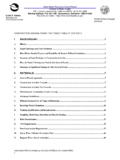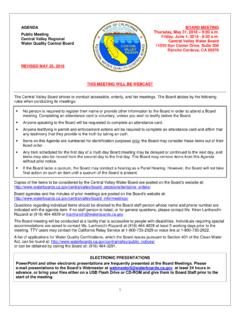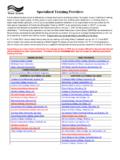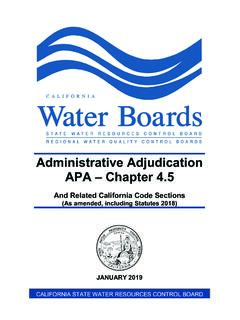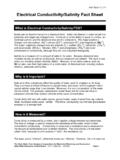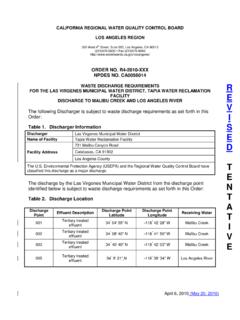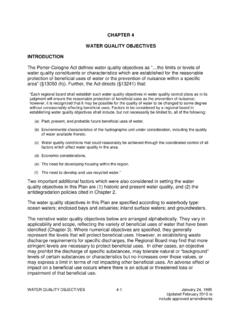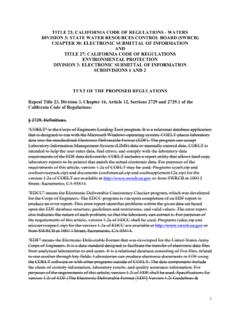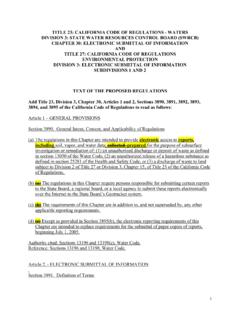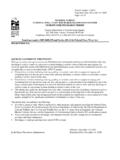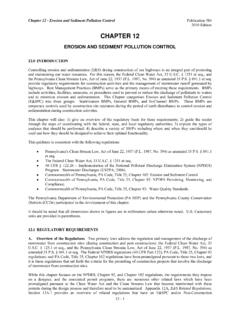Transcription of Storm Water Management in California
1 Storm Water Management in California Storm Water As A Resource The California Water Boards have been focused for more than 20 years in the area of Storm Water quality Management and regulation. The State and Regional Water Boards continue to strive to ensure that surface and ground Water resources are protected and managed in a sustainable manner for future generations. Recent state legislation and increased awareness of Storm Water -related environmental challenges and opportunities have contributed to continuously-changing innovative approaches to Storm Water Management and regulation. In 2016, the State Water Board adopted its Storm Water Strategy to further develop innovative regulatory and Management approaches to maximize opportunities to use Storm Water as a resource. For more information on the new Storm Water Strategy, please visit the following website: Water runoff from our cities, highways, industrial facilities and construction sites can carry pollutants that degrade Water quality and impact the beneficial uses of our waters - beneficial uses that belong to all Californians and entrusted to the California Water Boards to protect.
2 For nearly two decades, the State Water Resources Control Board (State Water Board), the Regional Water Quality Control Boards, and the US Environmental Protection Agency have regulated the runoff and treatment of Storm Water in industrial, municipal and residential areas of California . The various regulatory programs have the same goals - to use Storm Water as a resource and to reduce harmful pollutants, fertilizers, debris and other materials draining into our rivers, lakes and ocean. While early regulatory efforts focused on controlling pollutants and implementing best Management practices, current regulatory decisions also emphasize holistic strategies that will result in multiple community benefits while concurrently managing pollution. With the focus on Storm Water as a resource, newer low impact development and green infrastructure techniques are now capitalizing on opportunities to capture Storm Water runoff and use it for local landscape and agricultural irrigation, and groundwater recharge, with further description as follows.
3 - Low Impact Development (also referred to as LID) is a sustainable practice that benefits Water supply and contributes to Water quality protection. Unlike traditional Storm Water Management that collects and conveys Storm Water runoff through Storm drains, pipes, or other conveyances to a centralized Storm Water facility, LID takes a different approach by using site design and Storm Water Management to maintain the site s pre-development runoff rates and volumes. - Green Infrastructure (also referred to as GI) expands the low impact development approach to a larger community scale, and presents similar sustainable opportunities to local governments and regional projects. The California Water Boards are leading the way towards more Water -friendly landscapes in California . Storm Water capture through low impact development and green infrastructure also replenishes groundwater aquifers while concurrently reducing pollutants that would otherwise flow into our surface waters.
4 Federal and State Partnership The federal Water Pollution Control Act (Clean Water Act) provides the California Water Boards with the authority and framework for regulating Storm Water discharges under the National Pollutant Discharge Elimination System (NPDES) Permitting Program. (The EPA delegates tis federal permitting program to the State of California .) Cities and local jurisdictions that operate municipal Storm Water systems must obtain NPDES permit coverage for discharges of municipal Storm Water to waters of the Similarly, industry owners must have NPDES permit coverage for Storm Water from their industrial activity sites, and construction contractors must have NPDES permit coverage for Storm Water from constructions sites that disturb more than an acre of land. Storm Water Regulatory Programs The State and Regional Water Boards implement multiple Storm Water permitting programs as follows: - Municipal Separate Storm Sewer System (MS4) Permits: Large and small municipal sewer system operators must comply with ms4 permits issued by the State Water Board or applicable Regional Water Board.
5 ms4 permits regulate Storm Water entering local municipal systems under the following two phase system: Phase 1 ms4 permits regulate Storm Water permits for medium (serving between 100,000 and 250,000 people) and large (serving 250,000 people or more) municipalities. Phase I permits are issued by Regional Water Boards for municipalities within the corresponding region. For more information, visit the Municipal Phase I Storm Water Program webpage at: The Statewide Phase II MS4 permit regulates small municipalities (population of less than 100,000 people) and non-traditional small operations such as military bases, public campuses, prisons and hospital complexes that are not jointly regulated under a Phase I MS4 permit . The Statewide Phase II MS4 permit is issued by the State Water Board for regulation of small municipalities statewide. For more information, visit the Municipal Phase II Storm Water Program webpage at: - California Department of Transportation Phase I MS4 permit : The largest municipal Storm Water discharger in California is the California Department of Transportation (Caltrans).
6 The State Water Board regulates Storm Water discharges from this linear network of highways and road facilities through one statewide Phase I MS4 permit for Caltrans. For more information, visit the Caltrans Storm Water Program webpage at: - Statewide Construction Storm Water General permit : Storm Water from construction projects that disturb one or more acres of soil, or that disturb less than one acre but are part of a larger common plan of development, are required to obtain coverage under the statewide General permit for Discharges of Storm Water Associated with Construction Activity (also referred to as the Construction General permit or CGP). The CGP regulates construction Storm Water based on project-specific overall risk. The CGP requires temporary and post-construction best Management practices and measures to prevent erosion and reduce sediment and pollutants in discharges from construction sites. For more information, visit the Construction Storm Water Program webpage at: - Statewide Industrial Storm Water General Program: Industries with Storm Water from industrial activity areas are regulated by the Statewide Industrial General permit .
7 The Industrial General permit requires industry owners to implement the best technology available to reduce pollutants in their Storm Water discharges. In addition, industrial Storm Water dischargers are required to develop a Storm Water pollution prevention plan and monitor it in accordance with regulatory levels specified in the statewide permit . The Statewide Industrial General permit regulates over 10,000 industries in California . For more information, visit the Industrial Storm Water Program webpage at: Storm Water Multiple Application and Report Tracking System (SMARTS) The State Water Board manages an online database to allow permittees to electronically submit permit compliance data, and allows the public to view reports and information on Water quality control efforts with Storm Water . The online SMARTS database is located at the following website: Storm Water Funding Program The State Water Board s Division of Financial Assistance provides opportunities for applicants to receive grant or loan funding for Storm Water Management projects.
8 In November 2014, California voters approved Proposition 1 - the Water Quality, Supply and Infrastructure Improvement Act of 2014. Proposition 1 provides $200 million in grant funding for multi-benefit projects that utilize Storm Water as a resource, often while improving Water quality. The State Water Board also makes loan funding available through the Clean Water State Revolving Fund (CWSRF) loan program. The State Water Board continues to promote projects that convert Storm Water and dry weather runoff to a valuable Water supply through its funding program. The State Water Board provides funding assistance to applicants proposing to develop Storm Water Resource Plans and to implement projects from already developed plans as a means to advance the State Water Board s goal of improving Water quality while concurrently realizing multiple benefits. Eligible project types include projects that recharge groundwater aquifers with captured Storm Water , reuse Storm Water for domestic or municipal purposes, treat Storm Water to remove pollutants, support watershed processes, and beautify communities through creation of habitat and green spaces.
9 Eligible funding applicants include public agencies, non-profit organizations, mutual Water companies, and tribes. For more information, visit the Storm Water Grant Program webpage at: The CWSRF loan program offers low interest and principal forgiveness loans for projects that prevent pollution, including the construction of nonpoint source and Storm Water pollution control solutions. The Green Project Reserve is a CWSRF fund that provides principle forgiveness loans for projects that address sustainability issues, including green infrastructure that contributes to mitigating Storm Water runoff pollution. For more information, visit the CWSRF program webpage at: Additionally Emerging Innovative Areas of Study, Regulation and Monitoring - Regulation of Pre-Production Plastics The discharge of pre-production plastic pellets via Storm Water threatens California s aquatic environment. Potential sources of preproduction plastic pellets include manufacturers, transporters, warehouse operators, processors, and recyclers.
10 Some industrial facilities that either produce or handle these plastic pellets are regulated through the Statewide Industrial Storm Water permit . The Water Boards are investigating all aspects of this emerging area and taking appropriate actions. - Effects of Changes in Flows and Sediment Loads to Waterways Changes in flow and sediment loads to streams and other watercourses can result in significant and long-standing impacts to beneficial uses of our waters. Physical changes to Water bodies are collectively referred to as hydromodification. The California Water Boards have teamed with national scientists to develop and implement ground breaking ways to effectively and efficiently measure and regulate the impacts associated with hydromodification. Fact Sheet information provided courtesy of Division of Water Quality and Division of Financial Assistance staff. For further detailed information, please contact: Laurel Warddrip, Program Manager for the Industrial and Construction Storm Water Programs at Gayleen Perreira, Program Manager for the Municipal Storm Water Program (Including Caltrans) at Annalisa Kihara, Storm Water Strategy at Sean Maguire, Storm Water Grants Program Manager at
